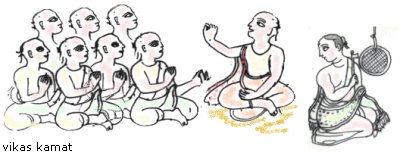Ashtavadhana
Eight Folded Talent Exhibition
by Dr. Jyotsna Kamat
First Online: April 17, 2004
Page Last Updated: December 07, 2024

Eight Folded Talent Performance
Sky is the limit for the questions, and could cover such fields as astrology, history, geography, literature, and science. Avadhani might be asked to complete a half-finished verse or explain philosophical terms. The peers take turns to engage the Avadhani, except one "Idiot Peer" who follows no rules! The bell keeper doesn't ring at regular intervals, further distracting the Avadhani, yet the performer has to strictly adhere to timings and display his sense of time. Ashukavis or "born-poets" stand a very good chance in such pneumonic feats.
Depiction of Ashtavadana performances are found in period literature and inscriptions. In the ancient times, a poet was supposed to master various subjects including music, dance, painting, martial arts, sports, pastimes, and many other allied subjects. Memory training was given in their childhood, and the Indian method of oral education certainly helped memorizing innumerable subjects. Ashtavadhanis (those who can perform this eight-folded act) were common in Kannada and Telugu royal courts, duly honored by the kings. There were Dashavadhanis (those who could take on ten scholars) and Shatavadhanis (those who could answer a hundred simultaneous questions) ! Folks with these last names can claim their ancestors were such scholars.
There are a few Ashtavadhanis in Andhra Pradesh even now (Year 2004). Dr. Ganesha R., an engineer by profession, has developed skills for this rare art of intellectual feat and has become an Ashtavadhani.
It is noticed that the art of Ashtavadhana was prevalent in other Indian languages like Tamil, Gujarathi and Hindi as well. But these days it has survived only in Telugu and to some extent in Kannada.
There used to be varieties in the art of Avadhana, like Sahithyavadhana (literary feat) Sangitavadhana (musical feat), Nrityavadhana (dance) and Chitravadhana (painting or illustration). This provided specialized amusement to those interested in different fields. But the most popular form, that of literature survived.
Many techniques are tried for spontaneous flow of words, right mode of expression and alertness. To top these, sharp memory is required. In the field of performing arts, such techniques are to be put to use for effective interaction. The master performer, Ashtavadhani or Shatavadhani, had to master the art of extempore speech and composing verse. At times riddle with only one line was given by the learned one in the audience, for which the Master had to add a second line in verse form only without losing a second's time. This art was known as Samasyapurti (solving a riddle).
This wonder of performing arts no doubt needed superb concentration, extraordinary memory-power, besides mastery in several subjects and sound general knowledge.
Some academicians are thinking of giving new orientations in modern fields through Ashtavadhana method. Spot-creation being the most coveted achievement. This ancient art may help in task management, target-oriented programming, management of emotions and operations research-some argue. Recently All India Seminar was held in Bangalore to explore such possibilities, through this ancient art of Avadhana.
![]()
See Also:
-
Amma's Column -- Dr. Jyotsna Kamat covers interesting topics in Indian culture, India's past, and some of the inspiring people she has met during her illustrious career.
